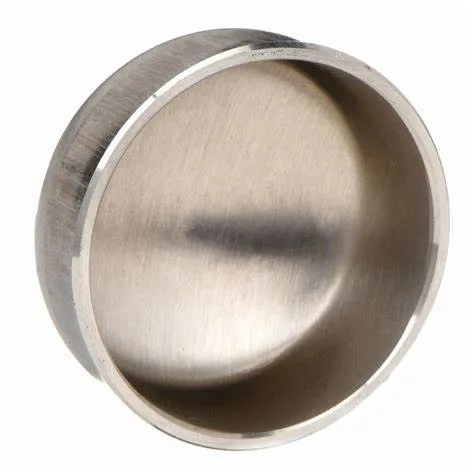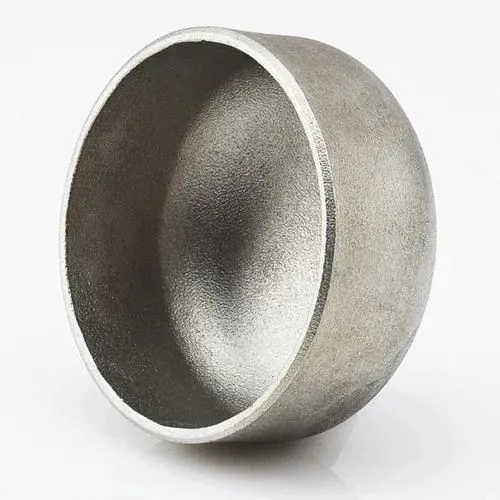JIS B2311 er japanskur iðnaðarstaðall sem nær yfir rasssuðu rörtengi, þar á meðal húfur sem notaðar eru í lagnakerfi. Stúfsuðuhettur þjóna þeim tilgangi að loka enda pípunnar, veita þéttingu til að koma í veg fyrir leka eða mengun. Hér er kynning á JIS B2311 skaftsuðuhettum:
- 1. JIS B2311 Standard:
- - JIS B2311 staðall tilgreinir kröfur um hönnun, mál, efni, framleiðslu og prófun á rasssuðufestingum, þar með talið hettum, í lagnakerfum.
- - Staðallinn tryggir að húfur sem framleiddar eru í samræmi við JIS staðla uppfylli gæðastaðla og séu samhæfðar öðrum leiðslum.
- 2. Rabbsuðuhetta:
- - Skaftsuðuhetta, samkvæmt JIS B2311, er festing sem er hönnuð til að hylja og innsigla enda rörsins á öruggan hátt, veita vernd og viðhalda heilleika lagnakerfisins.
- - Lokar eru notaðir við aðstæður þar sem pípuenda þarf að loka, annað hvort varanlega eða tímabundið, til að koma í veg fyrir leka, mengun eða til að klára kerfið.
- 3. Efni og smíði:
- - Stuðsuðuhettur samkvæmt JIS B2311 forskriftum eru fáanlegar í ýmsum efnum eins og kolefnisstáli, ryðfríu stáli og álstáli til að uppfylla mismunandi notkunarkröfur.
- - Þessar húfur eru framleiddar með stöðluðum byggingaraðferðum til að tryggja sterka og lekalausa tengingu þegar soðið er á enda rörsins.
- 4. Umsókn og fríðindi:
- - Stofsuðuhettur eru notaðar í ýmsum atvinnugreinum, þar á meðal olíu og gasi, efnaferlum, vatnshreinsistöðvum og fleira þar sem pípuenda þarf að vera tryggilega lokuð.
- - Lokar veita vernd pípuenda fyrir umhverfisþáttum, koma í veg fyrir mengun og hjálpa til við að viðhalda hreinleika og heilleika lagnakerfisins.
- 5. Uppsetning og suðu:
- - Réttar uppsetningaraðferðir, þar á meðal rétt uppröðun, undirbúningur pípuenda og suðutækni, eru nauðsynlegar við uppsetningu á rasssuðuhettum til að tryggja þétta og lekaþétta innsigli.
- - Suða er algeng aðferð til að festa lok á rör, sem veitir örugga og varanlega lokun sem þolir þrýsting, hitabreytingar og vökvaflæði innan kerfisins.
- Í stuttu máli eru JIS B2311 skaftsuðuhettur mikilvægir þættir sem notaðir eru í lagnakerfum til að þétta og vernda enda röranna á öruggan hátt. Þessar hettur eru í samræmi við staðlaðar kröfur til að tryggja gæði, áreiðanleika og eindrægni innan iðnaðarnotkunar þar sem pípulokun og vernd er nauðsynleg.
What Is a Butt Welding Cap and How Is It Used in Industrial Piping?
In industrial piping systems, end-of-line sealing and branch closures require robust solutions. A butt welding cap serves as a critical component for terminating pipes securely. By providing a seamless, welded closure, this fitting maintains system integrity, prevents leaks, and supports compliance with industry standards.
What Is a Butt Welding Cap?
A butt welding cap—also called a pipe end cap or buttweld end cap—is a round fitting designed to close off the end of a pipe. It’s manufactured to match the pipe’s outer diameter and schedule, with either a hemispherical or flat face. To install, both the pipe end and cap are beveled to form a V‑groove, enabling full‑penetration, fusion welds. Common materials include carbon steel, stainless steel, nickel alloys, and other engineered grades, chosen to satisfy pressure, temperature, and corrosion‑resistance requirements.
How Is Butt Welding Cap Used in Industrial Piping?
Butt welding caps find application across oil & gas, petrochemical, power generation, water treatment, and general process industries for both permanent and temporary closures. During hydrostatic testing, technicians install caps to seal off sections of piping while monitoring for leaks. In new construction or retrofit projects, caps terminate branch lines, future tie‑in spools, or dead‑end mains until system expansion. Welders prepare each joint by cleaning and beveling surfaces, aligning the cap precisely, and executing a root pass followed by filler passes per the qualified Welding Procedure Specification (WPS). Post‑weld heat treatment and non‑destructive examination (NDE)—such as radiography or ultrasonic testing—verify weld integrity and compliance with ASME B16.9 and related standards. Additionally, temporary caps enable safe isolation during maintenance, allowing for segment testing and dewatering under regulatory protocols.
Benefits and Best Practices
Butt welding caps offer a smooth‑bore transition that minimizes flow disruption and stress concentration. Their full‑penetration welds deliver exceptional structural strength and leak resistance. To optimize performance, engineers should:
Select caps with matching material grades and wall thicknesses
Adhere to proper bevel angles and joint fit‑up tolerances
Follow qualified WPS protocols rigorously
Consider cladding or protective coatings in corrosive environments to extend service life
Regular inspection and thorough documentation ensure long‑term reliability and safe operation under demanding conditions.
Butt welding caps are indispensable components for achieving durable, leak‑proof pipe terminations in a wide range of industrial applications.
Butt Welding Cap FAQs
What is a butt welding cap?
|
What materials are commonly used?
|
What standards govern butt welding caps?
|
How are butt welding caps installed?
|
Where are butt welding caps typically used?
|
What are the advantages of threaded caps?
|
















